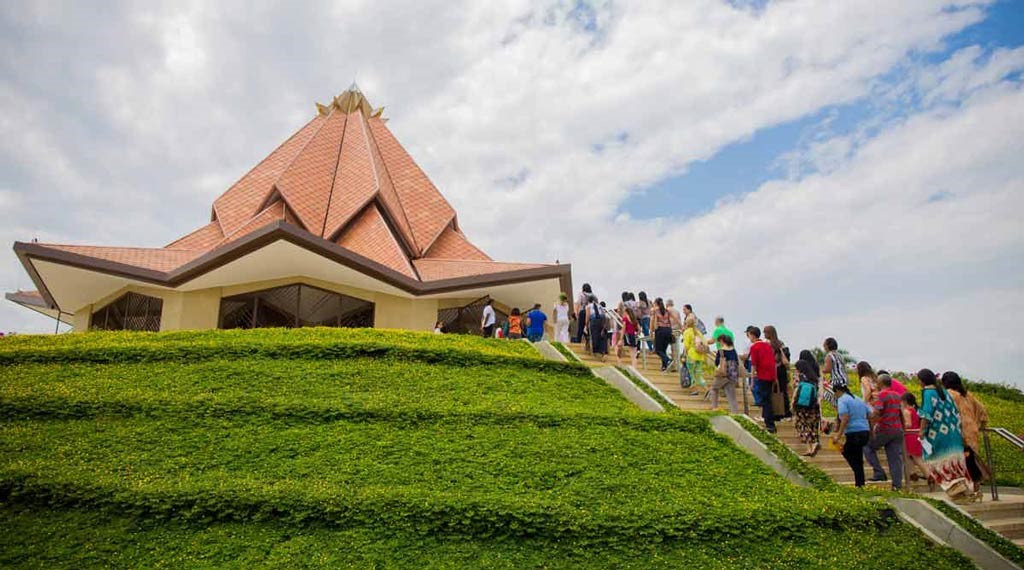Building a Temple on the foundation of unity
Laura Friedmann and Kyle Schmalenberg share the impact it had on them to travel from Canada to Colombia to film the completion of the House of Worship in Norte del Cauca, Colombia, built with the love and united efforts of an entire community.
Colombia is a country Bahá’ís are well familiar with, this is where the Ruhi Institute was founded. And the events that took place in the summer of 2018 in Norte del Cauca, Colombia, were far from standard. This was where the residents of the region were blessed to build and welcome people to their own Bahá’í House of Worship.
As any community that builds a House of Worship in the future may attest, it is a particular and significant moment in the history of that place. Our team was invited to attend as filmmakers and photographers to document this historical moment and we saw that it is so much more than a beautiful building. We noticed several beautiful things about the people we met, the place they’re from and the spirit – and perhaps destiny – that connects and binds them all.
The institution of the Mashriqu’l-Adhkár is a place where service and worship come together as one. This has been evident here since the beginning of its construction. For months people gathered regularly in “mingas”: a day of service where all come to assist with the needs of its construction, prayers are offered, and people rejoice together as close friends.
The dedication of the Local House of Worship in Norte del Cauca began 22 July and continued over the course of a month with events happening each Sunday. The day we arrived was two days before the first event, and the temple grounds still had a lot of work that needed doing. A call was made to hundreds of members of the community who willingly gathered with trucks full of food to provide meals. Everyone worked together in unity. Everyone was part of a system. People didn’t dig up a spot, grab sod, lay it down and water it all by themselves. There were people going around delivering pieces of grass to the diggers who were making space for others to lay it down and then still more people would come to water it. It truly seemed that the word ‘service’ was not thought of as an act that had a beginning and an end, but rather that it was synonymous with “life” and “living.” So implicit was the belief in the purpose of the work that needed to be done and so happy was each person in their labour that at times it would seem that people’s faces dissolved and instead became the same joyful servant of God. It was clear that this place of adoration had become a part of everyone’s life. It was home, and all took ownership.
Just by looking, you couldn’t tell who was a junior youth animator, a National Spiritual Assembly member, a Counsellor, the temple director or a volunteer from abroad. You could only see people doing the work that needed to be done. This struck us because it suggested the pre-existence of a common understanding, a collective will, a mutual and indisputable respect between each individual regardless of age and no matter the “status” they may have in the community or society at large. It presented an impeccable spirit of service and a coherent approach to life. It’s the kind of spirit that is nurtured and earned by decades of fostering love and justice in a community. The kind that ingrains in its minds and hearts a deep understanding of the oneness of humanity and the unfolding Revelation of Bahá’u’lláh. The kind that doesn’t separate and dichotomize singular realities to allow forces of disintegration to take root. It’s the kind that is resilient and steadfast when inevitably inside or outside circumstances put stress on it all.
Arguably the most gripping physical expression of the understanding of oneness and unity is the way in which the Temple is tied to the “Bosque Nativo” (Native Forest) project. The Mashriqu’l-Adhkár includes 11 hectares of native forest, and its volunteers are dedicated to protecting the disappearing regional native flora and fauna that has been lost because the land here has been forced into homogeneity and monoculture farms of sugar cane which dominated the once incredibly diverse land for decades.
Through their work, the land was stripped of all existing crops and, as if celebrating the freedom it had long awaited, exhaled and began to grow back dozens of plant species. It then welcomed new species of birds and animals, unprompted. So now, the House of Worship, which draws on the beauty and diversity of the garden of humanity, overlooks from its hill a lush and wondrous forest grown from seeds that must have laid latent in the soil, waiting patiently for their time to rise.
The day of the dedication arrived, and we witnessed the arrival of over a thousand people. The flame of certitude and faith shone bright in people’s eyes, as did the joy that emanated from their faces as they saw, some for the first time, the outcome of the spiritual seeds that had been planted decades ago. The mayor of Norte del Cauca spoke with proud words of admiration, musicians and dancers told the stories of their ancestors who arose from long-standing oppressive forces, prayers were sung, and the day was filled with fulfillment and satisfaction.
For us to see – very tangibly – the fruits of people’s worship and service was incredibly moving. It brought us hope that our surroundings can be transformed with collective and unified action, and that our spirits can be uplifted in the same way through collective and unified service. People, those who take ownership a physical space, who give it movement and life, who bless it with the Words of God and service in His name, are always and will always be the drivers of progress towards the kind of communities and societies Bahá’u’lláh has prescribed His teachings for.
Watching a people and a region rejoice is a testament to the merits of the effort required by a community who takes ownership over its own spiritual destiny. Without the House of Worship they are still a region that values its natural resources. It’s still a community that values its academic and spiritual education. It’s still a place full of people serving together to realize the vision of God for this day. And with that established as the foundation, it becomes a source of light and a force of attraction for all hearts and souls, with its House of Worship testifying to its hard-won history and welcoming everyone to take part in its brilliant future.
Laura Friedmann and Kyle Schmalenberg
Category: Uncategorized









